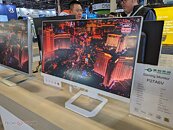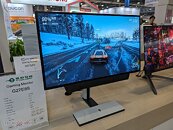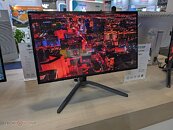- Joined
- Oct 9, 2007
- Messages
- 46,439 (7.66/day)
- Location
- Hyderabad, India
| System Name | RBMK-1000 |
|---|---|
| Processor | AMD Ryzen 7 5700G |
| Motherboard | ASUS ROG Strix B450-E Gaming |
| Cooling | DeepCool Gammax L240 V2 |
| Memory | 2x 8GB G.Skill Sniper X |
| Video Card(s) | Palit GeForce RTX 2080 SUPER GameRock |
| Storage | Western Digital Black NVMe 512GB |
| Display(s) | BenQ 1440p 60 Hz 27-inch |
| Case | Corsair Carbide 100R |
| Audio Device(s) | ASUS SupremeFX S1220A |
| Power Supply | Cooler Master MWE Gold 650W |
| Mouse | ASUS ROG Strix Impact |
| Keyboard | Gamdias Hermes E2 |
| Software | Windows 11 Pro |
INNOCN brought its latest gaming monitors to the 2024 International CES; it didn't waste out time with monitors based on 15 year old tech; but rolled out the very latest—IPS with miniLED backlighting, and OLED. The Titan Army P27A6V is a 27-inch planar display with 4K Ultra HD resolution and a blistering 144 Hz refresh rate (which is high, considering this is 4K). This display uses an IPS panel with miniLED backlighting, and meets DisplayHDR 1000 spec. Display connectivity include HDMI 2.1 and DisplayPort 1.4, both of which provide enough bandwidth of 4K HDR @ 144 Hz. Brilliant stuff, but this is "only" a 27-inch display, which will incur Hi-DPI scaling. Need something bigger? Check out the Titan Army P32A6V, which has identical specs to the P27A6V, but in a larger 32-inch planar format. Both these displays come in gunmetal gray and matte-white body color variants.
Switching up gears is the INNOCN M27E6V, a 27-inch planar display with a Fast IPS panel paired with miniLED backlighting. This one provides 4K Ultra HD with even faster 160 Hz refresh rate, and support for HDR 1400, and 99% coverage of DCI-P3. Inputs include DisplayPort 1.4, HDMI 2.1, and USB type-C (DisplayPort passthrough). You can use the monitor in single cable mode if the USB-C connection is capable of delivering 90 W. The next premium display is the Titan Army G27E8S, a 26.5-inch planar display that uses an OLED panel, and meant for performance gaming. You get a lower WQHD (2560 x 1440 pixels) resolution than the other three displays we mentioned so far; but at higher 240 Hz refresh rate, and under 0.5 ms GTG response time, thanks to the OLED panel. Inputs include DisplayPort 1.4 and HDMI 2.1. The display meets HDR10 spec.





The flagship display at the INNOCN booth is the 49E9S. This 49-inch curved super-wide display with an 1800R curvature, uses a QD-OLED panel, with a 32:9 aspect ratio, and an impressive 5120 x 1440 pixels native resolution at a blistering 240 Hz, with sub-0.5 ms response time. It meets HDR400 TrueBlack specs. Inputs include DisplayPort 1.4, HDMI 2.1, and USB-C (DisplayPort passthrough), and much like with the M27E6V, you can use this thing in single cable mode if the USB-C can deliver 90 W.

You can find more information about their products, at the INNOCN website.
View at TechPowerUp Main Site
Switching up gears is the INNOCN M27E6V, a 27-inch planar display with a Fast IPS panel paired with miniLED backlighting. This one provides 4K Ultra HD with even faster 160 Hz refresh rate, and support for HDR 1400, and 99% coverage of DCI-P3. Inputs include DisplayPort 1.4, HDMI 2.1, and USB type-C (DisplayPort passthrough). You can use the monitor in single cable mode if the USB-C connection is capable of delivering 90 W. The next premium display is the Titan Army G27E8S, a 26.5-inch planar display that uses an OLED panel, and meant for performance gaming. You get a lower WQHD (2560 x 1440 pixels) resolution than the other three displays we mentioned so far; but at higher 240 Hz refresh rate, and under 0.5 ms GTG response time, thanks to the OLED panel. Inputs include DisplayPort 1.4 and HDMI 2.1. The display meets HDR10 spec.





The flagship display at the INNOCN booth is the 49E9S. This 49-inch curved super-wide display with an 1800R curvature, uses a QD-OLED panel, with a 32:9 aspect ratio, and an impressive 5120 x 1440 pixels native resolution at a blistering 240 Hz, with sub-0.5 ms response time. It meets HDR400 TrueBlack specs. Inputs include DisplayPort 1.4, HDMI 2.1, and USB-C (DisplayPort passthrough), and much like with the M27E6V, you can use this thing in single cable mode if the USB-C can deliver 90 W.

You can find more information about their products, at the INNOCN website.
View at TechPowerUp Main Site





 It usually is on PC monitors or input lag will be horrible.
It usually is on PC monitors or input lag will be horrible.